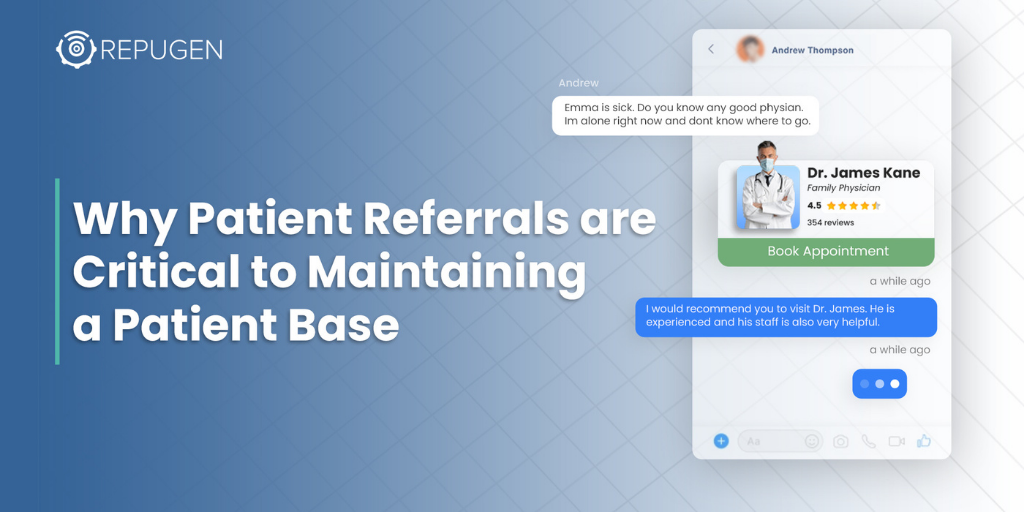
Tap play to enjoy this article, and don’t forget to subscribe to RepuGen on Spotify for more insightful podcasts!
In This Article
This blog explores how patient referrals can transform your healthcare practice by building a strong, loyal patient base through trusted recommendations. It details the benefits of a structured patient referral program, outlines practical steps for creating one, and shares expert insights that highlight the real-world impact of referrals on growth and credibility.
Few strategies are as effective or overlooked as patient referrals when building and sustaining a thriving patient base. While marketing campaigns and advertising efforts certainly help, nothing carries more influence than a trusted recommendation.
60.11% of patients consider referrals from family and friends one of the most important factors when choosing a new provider. Similarly, 58.08% rely on referrals from other healthcare professionals. This trust-based marketing is powerful because people naturally value the opinions of those they know and respect.
By prioritizing patient referrals, your practice can attract new patients while reinforcing the loyalty of your existing ones without the hefty price tag of traditional marketing.
A patient referral occurs when a satisfied patient recommends your practice to someone they know. While referrals often happen organically, a patient referral program gives this process structure and consistency. It encourages happy patients to actively spread the word while making it easy for them to do so.
An effective referral program brings in new patients while strengthening your relationship with current ones. It's one of healthcare's most cost-effective growth strategies with minimal overhead and high return potential.
For a referral program to succeed, it needs two key ingredients: enthusiastic staff and satisfied patients. Your team must be proactive in requesting referrals, and patients must have a positive enough experience to recommend your practice willingly. Here's how to get started:
Before launching your referral program, assess the overall patient satisfaction at your practice. High satisfaction levels are a strong indicator that patients will be motivated to recommend your services to others.
"My experience working with healthcare providers has shown me that patient referrals are one of the most effective ways to maintain and grow a strong patient base. Unlike traditional marketing, referrals come from trusted sources-other doctors, satisfied patients, or specialists-which makes referred patients more likely to follow through with treatment and stay loyal to a provider.
One example that stands out is a dermatology clinic I worked with. While they invested in digital marketing, their highest-quality patients those who completed treatments and returned for follow-ups came from referrals by general physicians and past patients. These patients already trusted the provider before their first visit, making them more engaged and likely to have better outcomes.
Beyond bringing in new patients, referrals also build credibility within the medical community. When a specialist consistently receives referrals from primary care doctors, it strengthens professional relationships and positions them as a trusted expert. This not only sustains a steady patient flow but also opens doors for collaborations, industry recognition, and long-term growth.
Referrals also lead to better patient outcomes. When a referring doctor shares a patient's medical history, the receiving provider can deliver more personalized and effective care. This seamless transition improves the patient experience, leading to higher satisfaction and even more word-of-mouth referrals.
From a business perspective, referrals are a cost-effective way to acquire new patients. While paid marketing can be expensive, referrals come at little to no additional cost and tend to bring in higher-value patients. Practices that actively build relationships with referring providers and engage satisfied patients through follow-ups, reviews, and loyalty programs often see steady, sustainable growth.
Ultimately, patient referrals create a cycle of trust providers deliver excellent care, patients share their positive experiences, and new patients arrive with confidence. This strengthens a provider's reputation and ensures long-term success in maintaining a loyal patient base."

Define specific, measurable objectives. For example, aim to acquire five new patients through referrals each quarter. Assign someone to track and manage the program's progress.
"People seeking health care often feel overwhelmed by the sheer number of options available, unsure of where to turn or what type of care they truly need. This uncertainty can lead to hesitation, causing individuals to second-guess their decision, delay seeking treatment, or avoid it altogether.
This is especially true for those struggling with addiction or mental health issues, where self-doubt, fear, or stigma can be significant barriers to care. A referral simplifies the process by providing a trusted recommendation from a credible source, offering a clear path forward. When a provider personally refers a patient, it removes much of the uncertainty, reinforcing that they are making the right choice.
This level of reassurance can be life-changing, as hesitation in seeking treatment can worsen conditions over time. A strong referral network ensures that individuals receive timely intervention, often serving as the crucial push they need to take action. In cases of addiction or severe mental health conditions, this immediate guidance can be the difference between prolonged suffering and lifesaving care."

Make patients aware of your referral initiative. Display signage in waiting areas, hand out reminder cards and encourage staff to mention referrals during check-out. You can also email or SMS campaigns asking patients to refer friends or family.
"Patient referrals are really important because they help connect people with the right specialists. When a doctor refers a patient, it's usually because they trust that provider's expertise. This not only makes the patient feel more confident but also helps them get the right care faster.
Plus, for healthcare providers, referrals keep the practice growing by bringing in patients who already have a level of trust in their care. I've seen how powerful referrals can be. A family doctor once sent a young patient to me because they were struggling with vision issues that weren't getting better. Since the doctor trusted my experience, the parents felt reassured, and we were able to quickly diagnose and treat the problem.
Later, that family even referred other parents facing similar concerns. When patients and doctors trust you enough to send others your way, it really shows the value of good care and strong professional relationships."

Build and maintain relationships with other healthcare providers. These partnerships, built on a foundation of high patient satisfaction in healthcare, can result in valuable cross-referrals that expand your patient network.
"Many patients don't know how to advocate for their own healthcare needs, especially when navigating complex medical or behavioral health systems. A referral serves as a guiding hand, ensuring they receive the right care at the right time without feeling lost or overwhelmed.
In addiction recovery, for example, individuals often require more than just medical treatment, they need access to peer support groups, vocational training, sober living arrangements, and long-term counseling. Without a structured referral system, many patients might miss out on critical services that could significantly improve their chances of sustained recovery.
Strong referral networks don't just benefit healthcare providers by maintaining a steady patient base, they create a pathway for individuals to receive the care they truly need. By ensuring patients are placed in the right programs and connected with the right professionals, referrals reduce confusion, improve treatment engagement, and ultimately lead to better outcomes. A well-coordinated referral system supports both the provider's mission and the patient's long-term success."

Use automated tools to send referral requests after visits. This will make it easy for patients to share your practice with others and ensure consistency, even during busy periods.
"I'm excited to share how patient referrals have been crucial in my experience leading Mission Prep's adolescent services. When we receive referrals from trusted colleagues, I've noticed these patients often come better prepared and more open to treatment since they've already built trust through their referring provider.
Just last month, a referral from a local pediatrician helped us connect with a teen struggling with anxiety who might not have found us otherwise, and now they're making fantastic progress in their treatment plan."

Patient loyalty is significantly enhanced when individuals actively refer their friends and family to a provider they trust. This act of referral serves as a powerful endorsement that not only brings in new patients but also reinforces the commitment of existing ones. Over time, this cycle of trust and recommendation builds a robust, loyal patient base that underpins the practice's long-term success.
"Referrals are vital to any physician who wishes to build and maintain a loyal patient base. If a patient brings a friend into your practice, it's not just a referral, it's a personal endorsement of the care and outcome you achieve. Individuals trust their friends and relatives, and therefore a referral carries credibility that no advertisement can replicate.
For instance, the result of a dental implant procedure is life-changing. A satisfied patient who regained confidence after the success of the implant procedure is likely to recommend it. This not only generates new business but also promotes your practice through word of mouth. Referrals enable you to expand organically, reaching a population that could not have learned about you through conventional marketing methods.
Most importantly, referrals build firm, long-lasting relationships with your patients. A person feels comfortable enough to send a friend or relative to the practice when they are content with their experience. It speaks volumes about providing value that goes beyond purely technical treatment.
In turn, this patient loyalty drives sustained growth, ensuring the long-term success of your practice. In short, referrals are a potent, effective tool for medical professionals to grow and prosper."

Patient referrals are more than just a marketing tactic; they reflect the trust and satisfaction you've earned. When happy patients recommend your practice, it boosts your credibility and attracts high-quality leads.
A well-structured referral program doesn't just bring in new patients; it strengthens your practice's reputation, increases loyalty, and drives sustainable growth. Don't leave this powerful opportunity untapped. The sooner you get started, the sooner you'll see the results. Let's look at the expert insights to know the real-world perspectives on patient referrals:
Patient referrals expand a provider's reach by bringing in new patients through trusted recommendations. Satisfied patients share their positive experiences, which often translates into new, engaged patients who will likely stay loyal. This organic growth method increases patient numbers and strengthens the overall community of care around the practice.
A personal referral cuts through the confusion of countless healthcare options by offering a clear recommendation from someone trusted. It reduces the overwhelming nature of choosing a provider, making the decision process more straightforward and less stressful. The referral guidance helps patients feel confident in their choices, leading to better initial satisfaction with care.
Referrals are critical in ensuring patients are directed to the best healthcare professionals to address their needs. This approach leverages the trust of previous care experiences or professional networks to quickly match patients with the appropriate specialist. As a result, patients receive more targeted, efficient care, which can lead to improved health outcomes and a smoother treatment journey.
A structured referral system is a reliable guide through the often complex healthcare landscape. It ensures that patients are connected with the proper services and professionals at the right time, avoiding unnecessary delays or misdirected efforts. This guidance helps patients receive the correct treatment and supports continuity of care, which is essential for long-term well-being.
When a trusted individual recommends a healthcare provider, it sets the stage for a strong foundation of trust between the patient and the provider. This pre-established confidence encourages patients to be more open and forthcoming about their health concerns. Such openness enables providers to offer personalized care, resulting in a more effective and satisfying treatment experience.
Patient loyalty is significantly enhanced when individuals actively refer their friends and family to a provider they trust. This act of referral serves as a powerful endorsement that not only brings in new patients but also reinforces the commitment of existing ones. Over time, this cycle of trust and recommendation builds a robust, loyal patient base that underpins the practice's long-term success.
Patient referrals are among the most effective strategies for building and maintaining a thriving patient base. The insights shared throughout this blog, from growing a strong patient community to driving loyalty, underscore the critical role referrals play in enhancing care quality and reinforcing trust. When patients recommend your practice, it validates the excellent care you provide and attracts new patients who come pre-equipped with trust and confidence. A well-designed referral program is a powerful, cost-effective tool that fuels sustainable growth and strengthens professional credibility.
Beyond boosting your healthcare online reputation, RepuGen empowers providers to expand their loyal patient base through an automated referral campaign. If you want to enable satisfied patients to share your exceptional care with their loved ones, contact us or schedule a live demo to see the process in action!
0 Comment
Your email address will not be published. Required fields are marked *